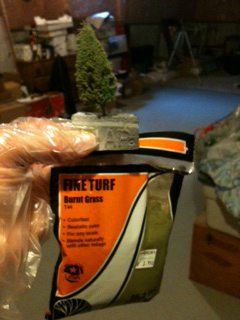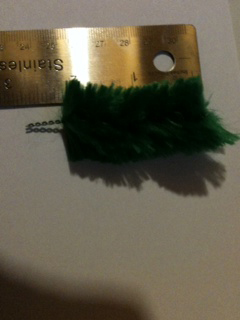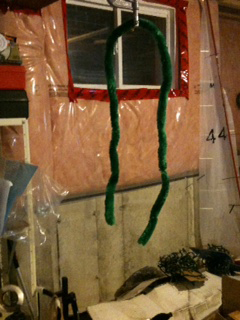“Hi Al
My tip is a modified version of a process, for making Z scale pine trees. Instead of twisting wire and chenille fibers in a drill, I got a long piece of a “giant chenille pipe cleaner” (see pictures ) which is 6.5′ long and 1″ (~18 scale feet) in diameter.
My local craft store carries these and it has fibers already twisted in wire. For a 40′ tree, I cut off a piece about 2.5″ long then remove about 1/2″ of fibers on one end to form a trunk.
The cylindrical shape is trimmed with scissors to form a typical pine tree shape then sprayed with hair spray and sprinkled with Fine Turf. Different trimming can vary the shape of the tree, so they don’t all look the same. If it will be seen, the “trunk” can be coloured with a furniture touch-up pen. The process takes about 5 minutes at most.
Hope this is useful to others.
Larry”
“Hi Al,
Thought you might be interested in the layout I’m building. It’s N gauge and modelled after Southern Germany in the 70’s & 80’s. It’s in a purpose built room attached to my wife’s craft room (which is located in a large shed ) with an adjoining door to take advantage of her A/C, and a door to the shed.
The room is 7 metres by 9 metres and I decided to build the layout in an “L” shape. Because of the limitations of the room the main framework was made with runners, made from drywall supports.
Then the actual layout framework was fitted with 16 castors made to take a total weight of 240 kilos. This allows the layout to be rolled forward for access to the back.
The layout consists of three main circuits all interconnected, one with a reverse loop incorporated. The height of the tracks raise from base level to 4 inches. The minimum radius is 15 inches. There are 12 electric points, 2 crossovers and 2 double slips. There will be multiple tunnel sections so infrared detector circuits were made to track the trains through these areas.
From the start of building the room till now has taken just on 12 months. I decided to go with DCC and after some trial and error I came to grips with it. I have a Tomix track cleaning car which is DC and I’d read that conversion to DCC was problematic, so I made the layout to operate on either DC or DCC enabling the cleaning car to be used with a DC loco.
Obviously the DCC locos are removed for this exercise. I made large clearly marked connectors for power supply so there’s no doubt about which power is being used. If you’re interested I’ll keep you informed as the layout progesses. You may remember the chair I made to do the wiring.
Regards
Roger”
I remembered Roger’s chair. Superb!
That’s all this time folks. Please do keep ’em coming.
Best
Al














Really great work Roger! I like the layout and would like to see more when you have compoleted it. Cheers Rossco
Please keep us up to date with this layout. And could we see a track plan too? It looks very interesting. Very neat woodwork! D/
I do not know if it would work for Roger or for me, but having Parkinson’s Disease and not able to always control my fingures and expect it to only get worse, I’m now planning to build a wide drawer that will pull out from under the tracks, and have a board/platform attached to the back of the drawer with a hinge that allows it to go up and another hinge about half-way from the back to the front that lets it bend down and back to expose small tools, material, etc. I plan to have an edge around the board built from 1/4″ X 1/4″ inch or 1/8 X 1/8″ balsa strips running all around the board to keep parts from falling into the drawer. I also want the “working board” to have a 2″ clearance from the drawers front and sides to catch any parts that do fall over the side.
I also have a small vice that I can mount on a board (like a thick cutting board) that will pull out beside the parts drawer with the same 1/4 in edging. Possibiy have indentations (made by a router to keep parts from rolling around
When I lived years ago in Southeast Asia, most houses in our village were made of woven bamboo, bamboo flooring and grass roofing. Fortunately our house, like teacher’s houses were made with cement block and wood, and I ran my HO train on “D” batteries. But I never dreamed that a layout like Roger’s could be run by batteries. WOW.
I’m very impressed with the creativity and conplexity of the layout.
Thank you, Roger, for the inspiration. If you can do it with your phyical limitations, maybe I can do something more complicated than my current planned layout..
Alan
Love the rollout feature Roger. Another bit of ingenuity and a well designed layout. Thanks for sharing.
Jim AZ
Al : ref to those print out buildings Can someone make some modern buildings banks stores diners,etc ? Many of us deal in up to date layout and don’t use Choo Choo’s We’re Diesel guys 1980’s to present.
Thanks Al
Looking good…….. I love that chair for under the table………
Really like the chair for working under the layout…
Hi
Al
Loving all your posts.
Notifying you of a change of email address
Nice start on your layout, Love the chair…
Beautiful start! Burnt Grass is wonderful for defining ridges, mountain tops and so on. I’m in a similar phase, keep building.
Rodger can you reprint the plans and details of the chair????? Thanks Ron from sunny Florida.
Roger, That looks like it’s going to be an interesting layout. I like the idea of having it on casters so you can roll it out from the walls. You said the room is 7 meters by 9 meters. That would be about 23 feet by 29.5 feet, but it doesn’t look that large in your photos and that would be a pretty huge N scale layout. Could it be that the entire building is 7 by 9 meters?
Also, since I’m planning to make my HO scale layout both DC and DCC compatible, why do you have to remove your DCC locos when running the DC track cleaning car? My understanding is that with DC there are no DCC signals goiing to the DCC engines so they should be idle and unaffected by the DC voltage. Am I missing simething here?
Keep us posted on your future progress.
Will
Roger, great start to your layout! I really like seeing the construction from scratch. Perhaps you can supply some more details. If the room is 7X9 meters, that will probably be a pretty large layout in N scale, I’d love to see a track plan. Also- can you post some details of how your castor system works? It looks interesting! I would also like to hear how you built the chair. Given the interest that everyone has shown, perhaps you can build them to sell!
Larry- good idea for the trees. They would also work as bushes in larger scales.
Hello. Please post the plans-and-components of your under-layout rolling chair. Looks very interesting. Thanks.
Roger
Great beginnings on your layout
I too would like more info on the chair
Bruce from Michigan
Larry, very god idea about making coniferous trees. The latest issue of the NMRA magazine has a piece in which the author makes pine trees branch by branch. I admit that they look great but must take a long time to make each one. Maybe just for foreground scenery? Roger, a good start. I assume the castors are so you can make the layout larger, putting the front against the wall while you are working on the back. .